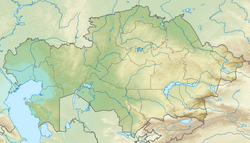Ilibalyk
 | |
| Alternative name | Ilanbalyk, Ilibaly |
|---|---|
| Location | Panfilov District, Jetisu Region, Kazakhstan |
| Coordinates | 44°07′14″N 79°53′04″E / 44.12056°N 79.88444°E |
| Type | Medieval city |
| Area | 5 km² |
| History | |
| Periods | 9th-14th centuries |
| Cultures | Karakhanid, Chagatai, Church of the East, Islam |
| Site notes | |
| Excavation dates | 2016-present |
Ilibalyk ('i:lɪbɑlɪk), also spelled Ilanbalyk or Ilibaly, was a major medieval Silk Road city in the Ili River valley of present-day southeastern Kazakhstan. Occupied from the 9th through the 14th centuries, the site comprises a fortified administrative core (shahristān), extensive suburbs (rābāds), and a large contemporary Nestorian necropolis.[1]
Etymology
[edit]The name “Ilibalyk” derives from Turkic "Ili-balyq", literally “city on the Ili (River).” Medieval Persian and Armenian chronicles record variants such as Ilanbalyk and Ilibaly.[2]
Location and geography
[edit]Ilibalyk stands near modern Usharal (Üsharal), Panfilov District, Jetisu Region, approximately 45 kilometres (28 mi) north of the present Ili River channel. The site spans some 5 km² of floodplain and a low ridge, commanding a route through the northern Tien Shan corridor.[1][3]
Historical context
[edit]From the 9th century, Ilibalyk lay within the eastern frontier of the Turkic Karakhanid realm; following the Mongol conquests it formed part of the Chagatai Khanate. Contemporary travelers, including Armenian King Hetum I (1255), mention Ilibalyk as a fortified riverine caravanserai and market town on the route between Central Asia and China.[2]
Archaeological research
[edit]Discovery and survey
[edit]A carved Church of the East gravestone discovered in 2014 near Usharal, Kazakhstan prompted a systematic archaeological survey of the site.[1] Since 2016, annual field campaigns have investigated the medieval city's core, including a fortified shahristān (approximately 380 x 350 m) and surrounding rābāds. Excavations have also documented a Christian necropolis measuring roughly 60 x 70 m, with over 110 graves excavated to date, as well as the remains of at least one associated funerary chapel.[3][4]
Necropolis (Nestorian cemetery)
[edit]Excavations beginning in 2016 uncovered an extensive medieval cemetery outside the western wall, with over 110 graves excavated to date (estimated total ~500). All burials adhere to east-west alignment, typifying Church of the East funerary practice; only ~18% contained grave goods (beads, bracelets, occasional silver pendants).[5]
Fifty-five grave markers (kayrāks) have been found bearing variants of the Nestorian cross, a few with Syriac inscriptions, some transliterating Old Turkic or Persian. A brick funerary chapel structure adjacent to the graves suggests communal liturgical activity. DNA and radiocarbon analyses are underway to determine the cemetery's demographic composition and chronology.[4]
Material culture
[edit]Surface collection and trenching have yielded:
- Numismatics: ~175 coins, predominantly Karakhanid (12th c.) and Chagatai (13th-14th c.), including issues from Almalyk (capital of the Chagatai Khanate)[3]
- Ceramics: Glazed wares, unglazed tablewares, lamps, vessels, dating 11th-14th c.
- Metallurgy: Iron tools (knife blades, horse fittings) and small silver ornaments.
- Jewelry: Beads, bracelets, rings, earings.
- Textile: Boqtaq-style headdress.
Architecture and bathhouse
[edit]Excavations of the shahristān revealed mudbrick ramparts (original height up to 6 m) and a monumental bathhouse (hamām) built with fired bricks and hypocaust heating. Adjacent ceramic kilns attest to on-site brick production during the Karakhanid-Chagatai period.[3]
Significance
[edit]Ilibalyk is one of the largest medieval sites in Zhetysu, illuminating Silk Road urbanism, Turkic-Mongol statecraft and the eastward spread of Church of the East Christianity. Its multi-ethnic material record add to current understanding of cultural interconnections in 13th-14th c. Central Asia.[1]
See also
[edit]References
[edit]- ^ a b c d "Society for Exploration of EurAsia: Ilibalyk Project". Retrieved 2025-07-06.
- ^ a b Hetum, Hetum I (1255). The Journey of Hetum I. Gyumri: Armenian Royal Archives.
- ^ a b c d Voyakin, Dmitriy (2019). "Excavations at Ilibalyk: Medieval City on the Ili River". Kazakh Archaeology Journal. 12 (1): 45–67.
- ^ a b "Medieval Necropolis Ilibalyk". UNESCO IICAS. Retrieved 2025-07-06.
- ^ Baipakov, Karl (2021). Medieval Christian Sites of Central Asia. Bern: Swiss Society for Exploration of EurAsia.
External links
[edit]- Exploration Eurasia: Ilibalyk Project
- IICAS/UNESCO Medieval Necropolis Ilibalyk
- ПАМЯТНИКИ ВОСТОЧНОГО ХРИСТИАНСТВА НА ТЕРРИТОРИИ КАЗАХСТАНА
- Preliminary Findings from the Cemetery at the Medieval Ilibalyk Site in Southeast Kazakhstan
- The Christian Community of Ilibalyk: Initial Archaeological Investigations of a Medieval Site in Southeastern Kazakhstan
- Ilibalyk Expedition, Kazakhstan
- Результаты археологических исследований средневекового городища Илибалык в 2021 году

